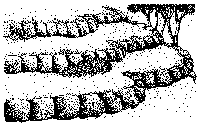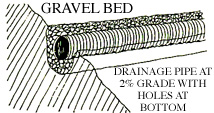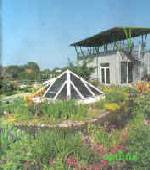Soil erosion occurs when soil particles are carried off by water or wind and
deposited somewhere else - such as into a stream or at the bottom of a bay.
Often soil particles are carried by runoff, water that does not soak into the
ground, but flows over the surface and runs to another area - such as into storm
drains, streams, or lakes. In addition to soil sediment, runoff can wash
fertilizer and other pollutants along with it. Sediment makes up most of the
pollutant carried by runoff, however, and most of the phosphate and pesticides
entering Virginia's waters are attached to these soil particles. Therefore,
controlling erosion will make a significant contribution to the control of water
pollution. Runoff entering lakes and streams, in addition to carrying
pollutants, is water that is needed to soak through the soil to resupply our
groundwater. Reducing erosion and runoff is important to protect both our soils
and our water supplies. Erosion and runoff in the home landscape also create
unsightly bare areas and deposit mud and dust on driveways and walkways that is
then tracked into the house.
Erosion begins when rain or irrigation water loosens soil particles. When
there is too much water to soak into the soil, it fills surface depressions and
begins to flow. With enough speed, this surface runoff carries away the loosened
soil. Runoff from roofs and paved areas can contribute to erosion by directing
large amounts of water in a short time period to nearby areas that are unable to
absorb it quickly enough.
Return to Table of Contents
Return to Table of Contents
-
Runoff may be supplying some of the water that collects on your property.
Look for runoff sources on your property or your neighbor's, such as
pavement, compacted soil, or roofs.
Return to Table of Contents
-
Nitrogen and phosphorus from fertilizers carried by runoff into our waters
have been associated with many environmental problems, including excessive
algae growth, depletion of the water's oxygen supply, and suffocation of
aquatic organisms.
Return to Table of Contents
Landscaping not only adds beauty and value to your property, but also helps
control erosion by reducing the amount and speed of runoff. Ground covers are
one of the best erosion controls and include any plant material that covers the
ground surface so the soil cannot be seen from above and rain does not strike
directly upon it.
Turfgrass is one important type of ground cover, but many other low-growing
herbaceous and woody plants work well and, once established, require less
fertilizer, pesticide, and other maintenance than turf.
Return to Table of Contents
 Steep slopes can be easily eroded and, even if erosion is controlled, may allow
water to collect in undesirable areas, such as near house foundations. There are
many ways to reduce erosion and runoff, as well as control the direction of
drainage.
Steep slopes can be easily eroded and, even if erosion is controlled, may allow
water to collect in undesirable areas, such as near house foundations. There are
many ways to reduce erosion and runoff, as well as control the direction of
drainage.
-
Build terraces or a retaining wall. These catch runoff, giving water time
to soak into the ground, and also make attractive planting beds. Be aware
that changing soil level near wellestablished trees can seriously damage
their root systems.
-
To redirect excessive runoff, install perforated drainage pipe just below
surface level across the direction of the slope. Drainage pipe should be
laid perforated side down at a 2 percent slope in a gravel bed. The end of
the pipe must be protected from clogging and must direct the water to an
area able to handle it.
Return to Table of Contents

Planting ground covers on slopes or bare areas helps control erosion and runoff
because plant roots hold the soil in place, and the leaves protect the soil from
the impact of raindrops, reducing soil compaction, and improving the speed with
which water soaks into the ground. Ground covers can produce attractive patterns
with variations in height, texture, and color. They also conserve soil moisture;
reduce maintenance in narrow or odd-shaped areas where mowing, edging, and
watering might be difficult; reduce heat, glare,-noise, and dust; and block foot
traffic without blocking the view. Some ground cover choices for Virginia
include:
Many other ground covers grow well in different part of US, consult your local
nursery garden centers or Park and Recreational dept in your town or city.
Return to Table of Contents
By caring for and improving your soil, you will help it absorb water more
readily, reducing runoff and erosion as well as improving plant health.
-
Add organic matter to your soil to improve the speed with which water
soaks into the ground, the ability of the soil to hold water, and soil
drainage. Leave grass clippings on the lawn and till leaves and compost into
flower and vegetable beds.
Return to Table of Contents
![]() Gardeners' Corner
Kids'
Garden
Sustainable Garden
Contact Us
Gardeners' Corner
Kids'
Garden
Sustainable Garden
Contact Us![]()




 Steep slopes can be easily eroded and, even if erosion is controlled, may allow
water to collect in undesirable areas, such as near house foundations. There are
many ways to reduce erosion and runoff, as well as control the direction of
drainage.
Steep slopes can be easily eroded and, even if erosion is controlled, may allow
water to collect in undesirable areas, such as near house foundations. There are
many ways to reduce erosion and runoff, as well as control the direction of
drainage. 